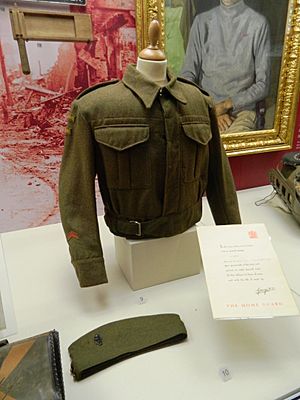Ulster Defence Volunteers facts for kids
The Ulster Defence Volunteers (UDV) and later the Ulster Home Guard were groups formed in Northern Ireland during World War II. Their job was similar to the Home Guard in Britain. The UDV started around May 1940, soon after the Home Guard began in other parts of the United Kingdom.
Unlike the Home Guard in Britain, the UDV was mainly made up of members from the Ulster Special Constabulary (USC). This group was also known as the 'B' Specials. This was because the government in Northern Ireland worried about giving weapons to everyone. They wanted to make sure weapons only went to people they trusted.
Contents
Why the Force Was Created
In May 1940, the Prime Minister of Northern Ireland, James Craig, 1st Viscount Craigavon, discussed creating a local defense group. He had some serious concerns about forming a group just like the Home Guard in Britain.
One big worry was that if they copied the British model, Roman Catholics might get weapons. The Minister of Public Security, John MacDermott, explained this concern. He felt it was important that weapons did not fall into the wrong hands. He believed the police could help the army decide who was trustworthy.
Craigavon asked the British Prime Minister, Winston Churchill, for advice on May 23, 1940. Churchill knew the 'B' Specials were a well-trained group. He gave Craigavon permission to create the new force. When Craigavon returned to Northern Ireland, he shared that Churchill appreciated Ulster's efforts to support the army.
How the Force Was Formed
The UDV was officially formed on May 28, 1940. Its members came from the 'B' Specials of the Ulster Special Constabulary. The government of Northern Ireland created this force. It was not controlled by the British Army in Northern Ireland.
In Britain, Home Guard members swore an oath to the Crown. But the UDV members were Special Constables. Their first official name was the "Local Defence Volunteers Section, Ulster Special Constabulary."
Later, the UDV became the Ulster Home Guard. The Royal Ulster Constabulary (RUC) managed them. This meant they were a special police-like force.
With the UDV, Northern Ireland's defense forces included:
- 3,000 Royal Ulster Constabulary officers
- 12,000 'B' Specials
- 12,000 UDV members
In 1942, the UDV in Northern Ireland changed into the Ulster Home Guard. They were then under military command and received uniforms. However, some USC units stayed in Belfast and Derry. They helped the RUC manage the large populations in these cities. Special Home Guard units were also set up in Belfast and Derry.
Recruitment Challenges
It was difficult to recruit people from the Roman Catholic population in Northern Ireland. We don't have exact numbers of how many tried to join. But it was generally thought that they were not encouraged to join.
By November 1942, only 150 Catholics were in the UDV. The total force had 40,000 members. John MacDermott noted that some Catholics did join. However, he said almost all of them left because they disliked the "B" Specials. He also said that while the "B" Specials had some issues, the Home Guard was quite divided. He felt this was partly because the minority group (Catholics) did not join.
What Their Duties Were
The UDV and Home Guard had important duties. They were prepared to fight against airborne invasions. They also watched out for "fifth columnists," which meant people secretly helping the enemy. In Northern Ireland, this often referred to the IRA.
Northern Ireland was seen as a special area because a large armed group (the IRA) wanted to overthrow the state. This kind of group did not exist in Great Britain. Both the British and Northern Ireland governments greatly feared German airborne landings. The governments in London, Dublin, and Belfast even had a secret plan called Plan W. This plan was for a joint response if Germany invaded Ireland.
Some members of the UDV and Home Guard trained for sabotage and guerilla fighting. This was part of their preparation for these plans.
Images for kids
See also
- Belfast Blitz
- Irish Republican Army–Abwehr collaboration – Learn about IRA links with Nazi Germany.
- Operation Green
- Plan Kathleen
- The Emergency



